by Sonia Badiali and Valeria Calderoni. Leggi in Italiano
Those of you who have ever found themselves discussing Westerns with Mik – or has taken a look at his favorite movie lists (part one and part two) – already know him as a purist of the classic Western and a detractor of the “spaghetti” genre, in part because of the large number of low-budget films of dubious artistic value made in Italy in the 1970s when the genre gained popularity (of course, this group does not include the films of Bud Spencer and Terence Hill, of whom “our” Mik is a big fan).
However, this doesn’t mean that, at the time when the genre was wildly popular, Mik wouldn’t regularly go to the cinema to enjoy the latest Italian western flicks; b-movies have always been much appreciated by the cinephile side of the family, but perhaps we find ourselves having conflicting opinions about how quickly their value wears off over time.
Maybe the almost “splatter” component of many spaghetti westerns, a delight for any horror cinema fan, is not as inviting to those who prefer a less “explicit” way of building tension. While Luca, Mik’s son-in-law and husband of our “saloon owner” Vanessa, loves the violent, barbaric italo-west by Castellari and Sollima, Mik prefers to watch movies that manage to create a crescendo of tension that can only be resolved in the final challenge – and as you well know, keeping the trigger under control is not an option in the impulsive world of the spaghetti western!
Nevertheless, even a classic western fan like Mik can’t help but love the origins of the spaghetti genre, when Leone shocked and excited audiences worldwide with his “Dollar Trilogy” and gave rise to a new era in western cinema that elevated him to the status of legend. We talked about this one morning a few months ago during a trip to Bologna, while commenting on the film we had watched the night before – The Great Silence by Sergio Corbucci: a favorite among the “youngsters” of the family and also appreciated by Mik, although… well, let’s hear it from him (subtitles on for English):
To look deeper into the issue, and give space to our variety of opinions about this genre that is close to our hearts and born in our country, we decided to share with you our lists of favorite spaghetti westerns by dividing them in… two recipes: “spaghetti in bianco” and “spaghetti al pomodoro” – you can easily guess why – starting with the origins and less explicit references to the genre: Leone, Eastwood, and spaghetti à la Mik!
Here’s our “white sauce” recipe: twelve films that trace the origins of the Italian spaghetti western with Leone and follow the trail of his influence on the American western with Eastwood, Sturges and Post. Several of this movies would not be considered to be fully part of the genre of course – but were strongly inspired by Leone, while remaining close to Mik’s taste for the more evocative and less frenetic atmospheres of the great classics.
We hope you’ll enjoy our selection and we’ll be in touch soon with our second juicy recipe: “spaghetti al pomodoro” Luca style, where we’ll discover the dirtiest and bloodiest side of Italian spaghetti western!
MIK’S CHOICE OF WESTERN MOVIES:
12 Spaghetti western “in bianco”
| Title | Director | Year |
|---|---|---|
| A Fistful of Dollars | Sergio Leone | 1964 |
| For a Few Dollars More | Sergio Leone | 1965 |
| The Good, The Bad and The Ugly | Sergio Leone | 1966 |
| Once Upon a Time in the West | Sergio Leone | 1968 |
| Duck, You Sucker! | Sergio Leone | 1971 |
| Hang ’em High | Ted Post | 1968 |
| Joe Kidd | John Sturges | 1972 |
| The Outlaw Josey Wales | Clint Eastwood | 1976 |
| The Pale Rider | Clint Eastwood | 1985 |
| Unforgiven | Clint Eastwood | 1992 |
| Django | Sergio Corbucci | 1966 |
| Django Unchained | Quentin Tarantino | 2012 |
A Fistful of Dollars by Sergio Leone, 1964
with Clint Eastwood, Gian Maria Volonté, Marianne Koch; 99 min.

The owner of the only saloon in San Miguel, a town on the border between Mexico and the United States, tells passing gunfighter Joe about the fight between two prominent families to gain control of the city. Joe decides to take advantage of it and sell himself to both in order to earn some money.
A Fistful of Dollars marked Leone’s transition from peplum to western cinema, and was the first installment in his “Dollar Trilogy”, followed by For A Few Dollars More and The Good, the Bad and the Ugly. It was conceived as an unofficial remake of Akira Kurosawa’s masterpiece Yojimbo, released in 1961: although Kurosawa greatly appreciated and admired Leone’s version of his own film, his production house filed suit against Leone, obtaining a percentage on the proceeds of all sales; the trial went on for over ten years and ended up costing Leone a loss of fifty million on the film.
The soundtrack by Ennio Morricone (under the name of Dan Savio) was a great success and the theme song of the movie, whistled and played by Alessandro Alessandroni, is one of the most celebrated in the world of western movies.
Fun fact: Leone was hoping to get Henry Fonda to play Joe, but the actor’s manager did not even show him the script; Leone then thought of James Coburn and Charles Bronson but the first asked for $25,000 and the latter refused the part. Eventually, albeit reluctantly, he chose a young actor who had starred in the American series The Prairie Men: Clint Eastwood.
For a Few Dollars More by Sergio Leone, 1965
With Clint Eastwood, Gian Maria Volonté, Lee Van Cleef; 132 min.

Two bounty hunters, Manco and Colonel Mortimer, are united in chasing El Indio, whose gang helps him escape from prison. During the escape, El Indio kills all the guards and the captain, leaving only one man alive so that he can tell everyone what he saw; a $20,000 bounty is then placed on his head. Manco infiltrates the gang while the colonel remains out of it: the ensuing robberies and deceptions prepare the ground for an unforgettable final duel.
In this second film of the “Dollar Trilogy”, Ennio Morricone’s soundtrack is again playing a central role in the movie, and was composed using a typical Sicilian instrument similar to an ocarina called marranzano, which in the context might seem indeed typical of the West.
Fun fact: the poncho worn by Clint Eastwood is the same used for “A Fistful of Dollars”, and it was never washed in order to obtain a “worn out” effect.
The Good, the Bad and the Ugly by Sergio Leone, 1966
with Clint Eastwood, Lee Van Cleef, Eli Wallach; 177 min.

The Good (known only as “Blondie”, the way Tuco calls him) and the Ugly (who goes by Tuco) are business partners: determined to squeeze everything possible from the bounty imposed on Tuco’s head, Blondie delivers Tuco to various sheriffs and collects the bounty only to then free him again, sharing the money with him. During one of their ploys, they meet the Bad (known as Angel Eyes), a ruthless hitman in search of a cash box buried in an unspecified cemetery. Having learned some fundamental details about the location of the hiding place, Tuco and “Blondie” join him in the search, despite the profound hostility they all feel towards each other.
Dollar Trilogy, part three. Upon release, the film divided critics but had great box office success and has since become a classic. Tarantino, a huge fan of Leone, lists it among the best films of all time.
Once again, the music is by Ennio Morricone. The main motif, reminiscent of the howling of coyotes, consists only of two notes and is used for all three main characters but played on different instruments: soprano flute for Biondo, ocarina for Angel Eyes and human voice for Tuco.
Once Upon a Time in the West by Sergio Leone, 1968
with Charles Bronson, Henry Fonda, Claudia Cardinale; 165 min.
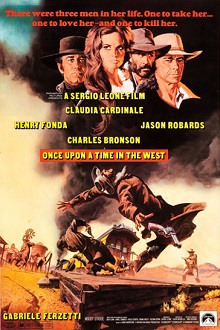
Brett McBain owns land in Sweetwater where the only water source in the area is located, and where he dreams of building a station for the future passage of steam locomotives. Shortly after marrying Jill, a former prostitute, by proxy, McBain is murdered by Frank, a hired gun paid for by his competitor Morton; the two then try to lay the blame on a bandit named Cheyenne.
Arriving in Sweetwater, Jill claims ownership of the land, putting herself in danger. In order to help her, Harmonica joins her in pursuit of Frank to avenge the death of her brother and Cheyenne.
Soundtrack signed by Ennio Morricone also for this film. The almost shrill sound of the harmonica sets the stage for some of the most iconic scenes in the film, and all characters have their own musical theme to accompany their arrival: for these and other reasons, the soundtrack to Once Upon a Time in the West is considered one of Morricone’s best compositions.
Duck, You Sucker! by Sergio Leone, 1971
with Rod Steiger, James Coburn, Maria Monti; 157 min.

Bandit Juan Miranda and his five sons are getting ready to rob a bank. During the Mexican Revolution, they meet John Mallory, an Irishman, who is a fervent supporter of the revolution and an expert dynamiter, and with him they plan to kill the new dictator. Juan and Mallory see in their alliance an opportunity of achieving their goals, and Juan finds himself involved in fighting alongside the insurgents of Zapata and Pancho Villa.
This is Leone’s most political film, and one that provides insightful commentary on a civilization divided between conservatives and revolutionaries, where any attempt at change is crushed and the possibility of truly changing the foundations of society remains a pipe dream.
The film begins with a sentence taken from Mao Tse Tung’s Little Red Book: “A revolution is not a dinner party… A revolution is an act of violence.”
Hang ’em High by Ted Post, 1968
with Clint Eastwood, Inger Stevens, Ben Johnson; 114 min

Jed Cooper, a former deputy sheriff turned cattleman, is wrongly accused of murder and of stealing cattle from the murdered man and is about to be hanged without trial. Sheriff Dave Bliss, who happens to be passing through the area and knows him as an honest man, rescues him and takes him to Fort Grant for trial. During the proceedings, the truth comes out and Jed is freed; however, he sets out on the trail of the people who wanted to kill him for revenge.
Released in the revisionist era, the film reflects on the figure of the gunfighter and the theme of revenge, prompting the audience to question who has the right to decide life and death and to what extent the courts can be relied upon to obtain justice. Released in the revisionist era, the film reflects on the figure of the gunfighter and the theme of revenge, prompting the audience to wonder who is entitled to decide on life and death and to what extent it is possible to rely on the law to obtain justice.
Despite being an American production, the movie is connected to the Italian tradition of “spaghetti western” through its style and content.
Joe Kidd by John Sturges, 1972
with Clint Eastwood, Robert Duvall, John Saxon; 88 min.
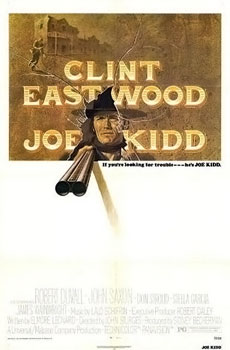
In Sinola, a town on the border between the United States and Mexico, a revolt of the peons against the landowners is underway. The latter ask for help from the expert Joe Kidd, who at first makes himself available, but soon realizes that the settlers are ferocious manhunters, and thus switches to the side of the Mexicans.
The Outlaw Josey Wales by Clint Eastwood, 1976
with Clint Eastwood, Sondra Locke, Chief George Dan; 135 min.
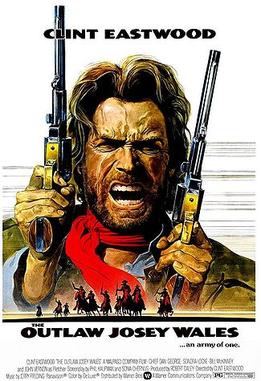
The movie, set at the time of the Civil War, explores the events related to the raids of guerilla bands marching through enemy territory and leaving behind a trail of death and destruction, often for personal revenge or money. One of these is the Kansas Brigade led by Captain Terril who, finding himself in Confederate territory, exterminates the family and burns the house of colonist Josey Wales.
Josey had not participated in the war, but having nothing left to lose he decides to join the southern gangs to avenge his family, becoming well known for his dexterity with firearms. After the Unionist victory, all his comrades surrender but he does not trust the Yankees and refuses to bow down to his enemies.
The film is inspired by a novel by former Ku Klux leader Klan Forrest Carter, initially titled The Rebel Outlaw: Josey Wales and later Gone to Texas. The book was revised and corrected to eliminate the racist component present in the text.
The protagonist is the same solitary, implacable and quick-thinking gunslinger that Eastwood had already interpreted so many times in Leone’s films.
Pale Rider by Clint Eastwood, 1985
with Clint Eastwood, Michael Moriarty, Richard Kiel; 116 min.
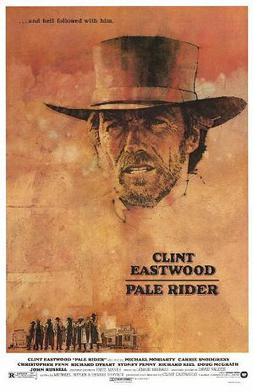
Mine owner Coy La Hood tries in every way possible to send away a group of gold miners who have legally established themselves in the mountainous area of North America. At first he tries in vain to pay them, then he turns to violence, sending his men to raid the prospectors’ camps. Shortly before the prospectors decide to leave and surrender, a mysterious stranger comes to their aid and encourages them to free themselves from the domain of La Hood. Loved by all, the stranger leaves as suddenly as he arrived to town.
John Russell, who had already played villain Nathan Burdette in Rio Bravo, was strongly sought after by Eastwood to play again the role of the villain in The Outlaw Josey Wales and Pale Rider.
Eastwood took his chances in shooting a western at a time when the genre was already facing a great decline in popularity; a few years earlier, Michael Cimino’s Heaven’s Gate, which costed 44 million dollars, grossed only $3.5 million, leading United Artists to bankruptcy. Pale Rider, on the other hand, was greatly successful both with critics and at the box office.
Unforgiven by Clint Eastwood, 1992
with Clint Eastwood, Gene Hackman, Morgan Freeman; 131 min
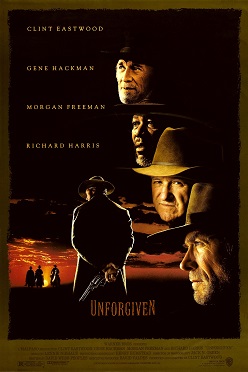
A prostitute’s co-workers, who has been scarred by two cowboys, set up a bounty of one thousand dollars to avenge her. Two men are attracted by the offer: English Bob, an old bounty killer, and Schofield Kid, a young and inexperienced gunslinger who also involves Munny, a criminal once famous for his robberies who has since changed his life. The sheriff’s wickedness and arrogance turn Munny once again into the ruthless killer he used to be.
Unforgiven has been called the last great American western. Nominated for nine Academy Awards, it won four: Best Movie, Best Director, best Supporting Actor and Best Film Editing.
In the credits, Eastwood dedicated the movie “to Sergio and Don” as a tribute to the two masters Sergio Leone and Don Siegel who were of great inspiration to him throughout his career.
Django by Sergio Corbucci, 1966
with Franco Nero, Loredana Nusciak, José Bodalo; 92 min.
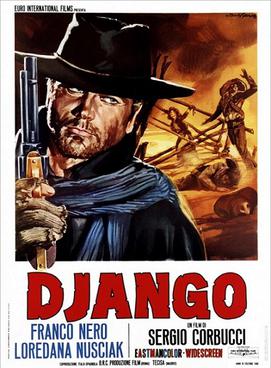
Django, a stranger wearing a Unionist uniform and dragging a coffin along with him, lands in a village where two rival gangs are engaged in a bloody rivalry. Here he meets Commander Jackson’s Red Shirts, who are battling General Rodriguez’s Mexican revolutionaries.
Django sets himself against both gangs: first he annihilates Jackson’s gang with the machine gun hidden in his coffin, then he snatches the gold of the Mexicans, which however capture him and break his hands. Even with his hands broken, Django does not give up the final duel set to take place at the town’s cemetery.
One of the most violent westerns of all time, its violence contributed to its success: Django’s character has become an unforgettable and widely celebrated icon of Western cinema, that inspired many movies including the next and last one on our list.
Django Unchained by Quentin Tarantino, 2012
with Jamie Foxx, Christoph Waltz, Leonardo di Caprio; 165 min.

Dr. Schultz (Waltz), a bounty hunter, buys the slave Django (Foxx) promising him freedom if he helps him track down the Brittle brothers on whose heads hangs a generous bounty.
After completing the operation, Django plans to leave in search of his wife and Schultz offers to help him. The undertaking turns out to be more complicated than expected when the two discover that Broomhilda has been purchased by a sordid slave trader.
Trivia: during filming, two serious accidents happened on set. Di Caprio cut himself by slamming his hand on the table, but continued to act and Tarantino continued to shoot the scene, which was then included in the film; Christoph Waltz fell off a horse and broke his hip, forcing Tarantino to use a carriage instead of the horse in several scenes.
The film went on to win two Academy Awards: Best Supporting Actor and Best Original Screenplay.
Cover image: Sad Hill Cemetery, Burgos, Spain, by Santiago Lopez-Pastor.


